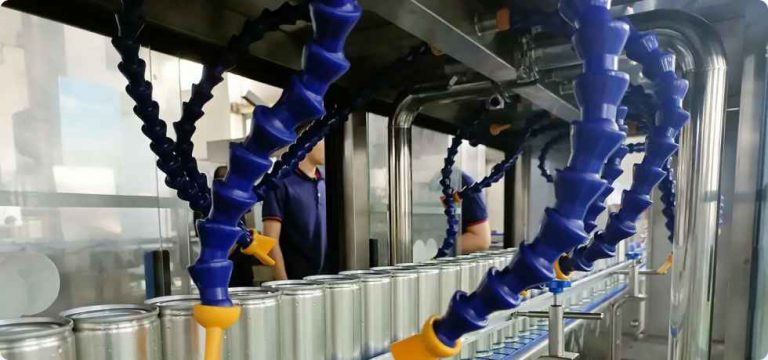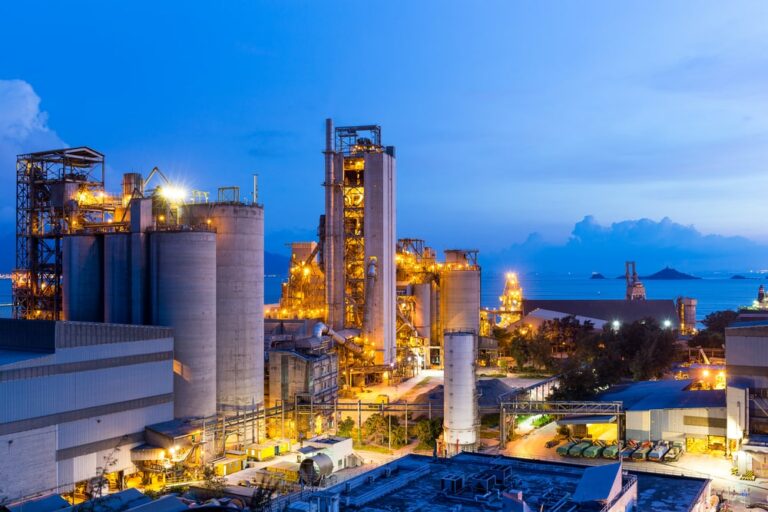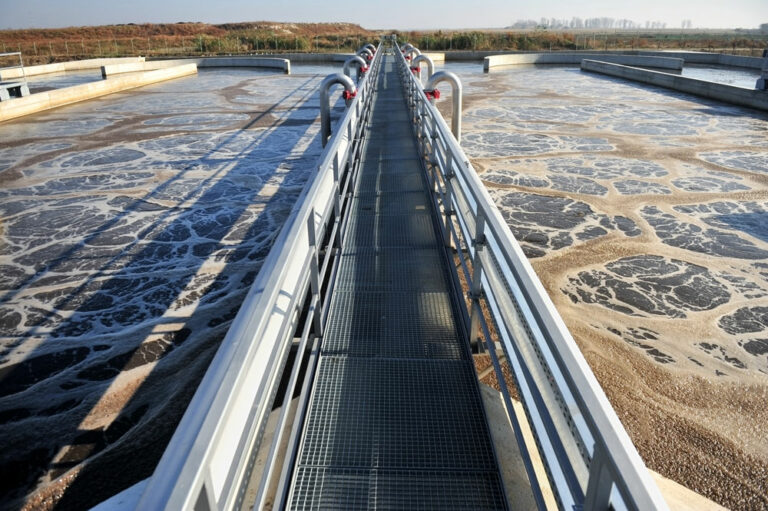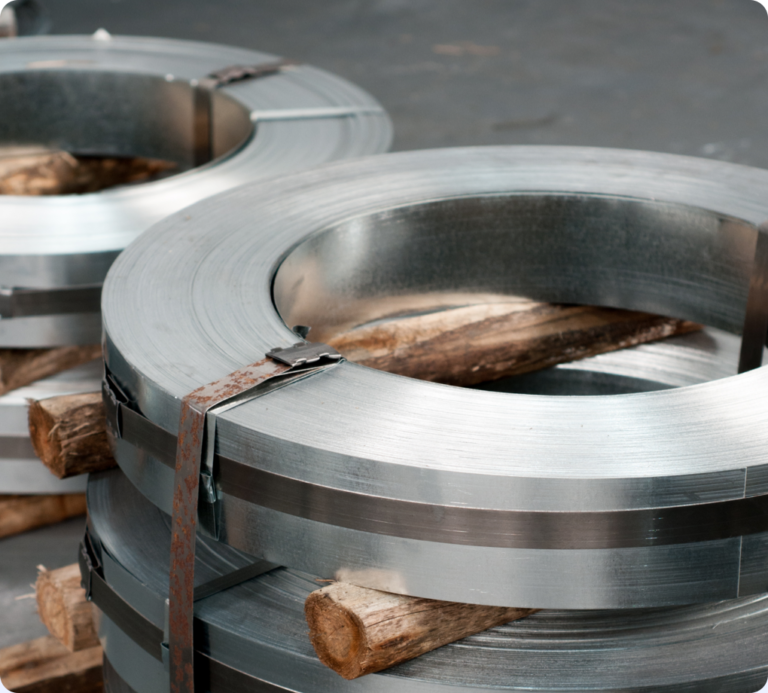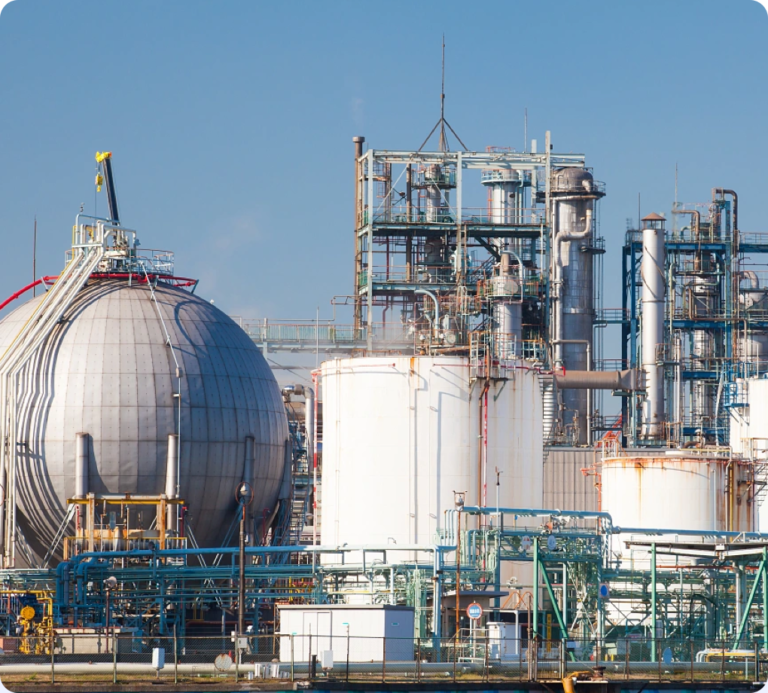Why centrifugal air suspension blower is suitable for stable and constantly running working conditions?
If we want to know the answer of this question,we need to know about the working principle of the air bearing blower:
1.the main parts of the air foil bearing blower is including:high speed permanent magnet synchronous motor,rotating shaft,air foil bearing,thrust bearing,ternary flow impeller,cooling impeller,VFD,PLC control system and other component.mini air blower
2.When the centrifugal air bearing blower connects with the power,the motor will run from low speed to high speed.Since the motor is connecting with the rotating shaft,and shafting connects with the air foil bearing, air foil bearing connects with the ternary flow impeller.The VFD is used for controling the motor running speed.When the motor is running is the speed lower than 8000rpm,the shaft and air foil bearing is touching with each other(If there is connection, there will be friction).The design of the bearing life is start-stop 20,000times.After the motor running speed is more than 8000rpm,the air force surrounding the air foil bearing will counteract the bearing gravity,then the bearing will float and running surrounding the shaft.leaf air blower
3.When the bearing of the air blower is running,it will bring the ternary flow impeller to run(since bearing is connecting with the impeller).After the ternary flow impeller runs,it will generate a vacuum area and suck the surrounding air into the ternary flow impeller,then the air will generate the dynamic pressure under the impeller compression,then the compressed air will be dischaged into the user pipeline.
4.When the shaft is rotating,it will bring the motor cooling impeller to run,the running impeller will form an vacuum area and suck the motor surrounding air inside.The air will go through the motor,bring the hot motor air to the vacuum area,then the hot air will be discharged outside the enclosure of the air blowers.
From the above working principle of air bearing blower,we can know that when we start-stop the blower,the air foil bearing has friction with the rotating shaft,when there is friction,there will be abrasion.Therefore,the air suspension blowers is not suitable for frequently start-stop working conditions.
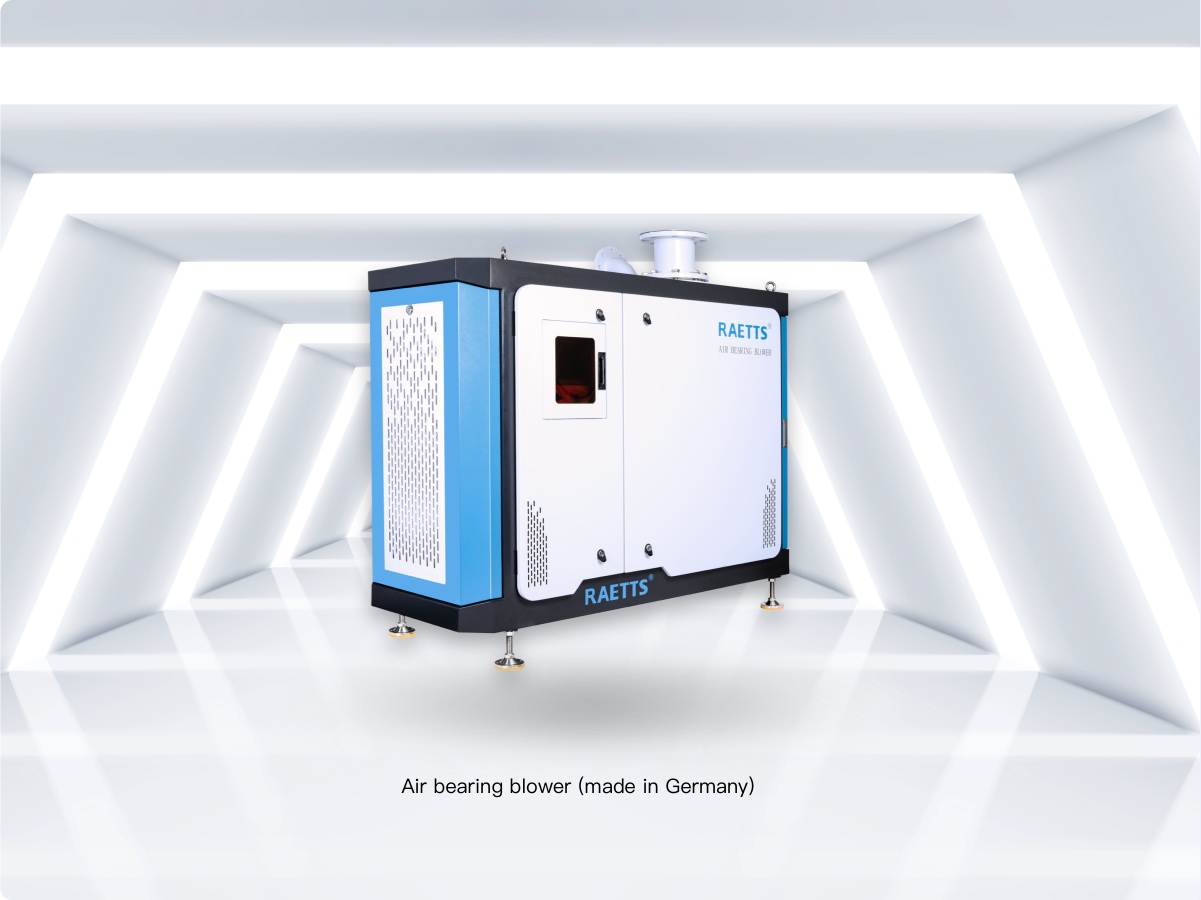
RAETTS standard type air bearing blowers,leaf air blower
RAETTS maglev turbo blowers are suitable for frequently start-stop working conditions,the applications of this mini air blower is including municipal wastewater treatment plant,sewage treatment plant,effluent water treatment plant,industrial waste water treatment plant(such as textile,automobile,Battery,PCB,etc),desulfurization and denitrification,backwash process and so on.leaf air blower
24 months warranty for the whole mini air blower
mini air blower good quality,good performance,good price,wide range applications,low noise
mini air blower Product packing information:1pcs/package
Origin information:made in China
RAETTS standard type air bearing blowers,leaf air blower
RAETTS air foil bearing blower is suitable for stable and constantly running working conditions(7days/24hrs running),mini air blowerthe applications is including sewage treatment plant,wastewater treatment plant,municipal wastewater treatment aeration,cement pneumatic conveying,coal powder pneumatic conveying,textile printing and dyeing wastewater treatment,galvanization industry,combustion support and so on.
Selection parameters table
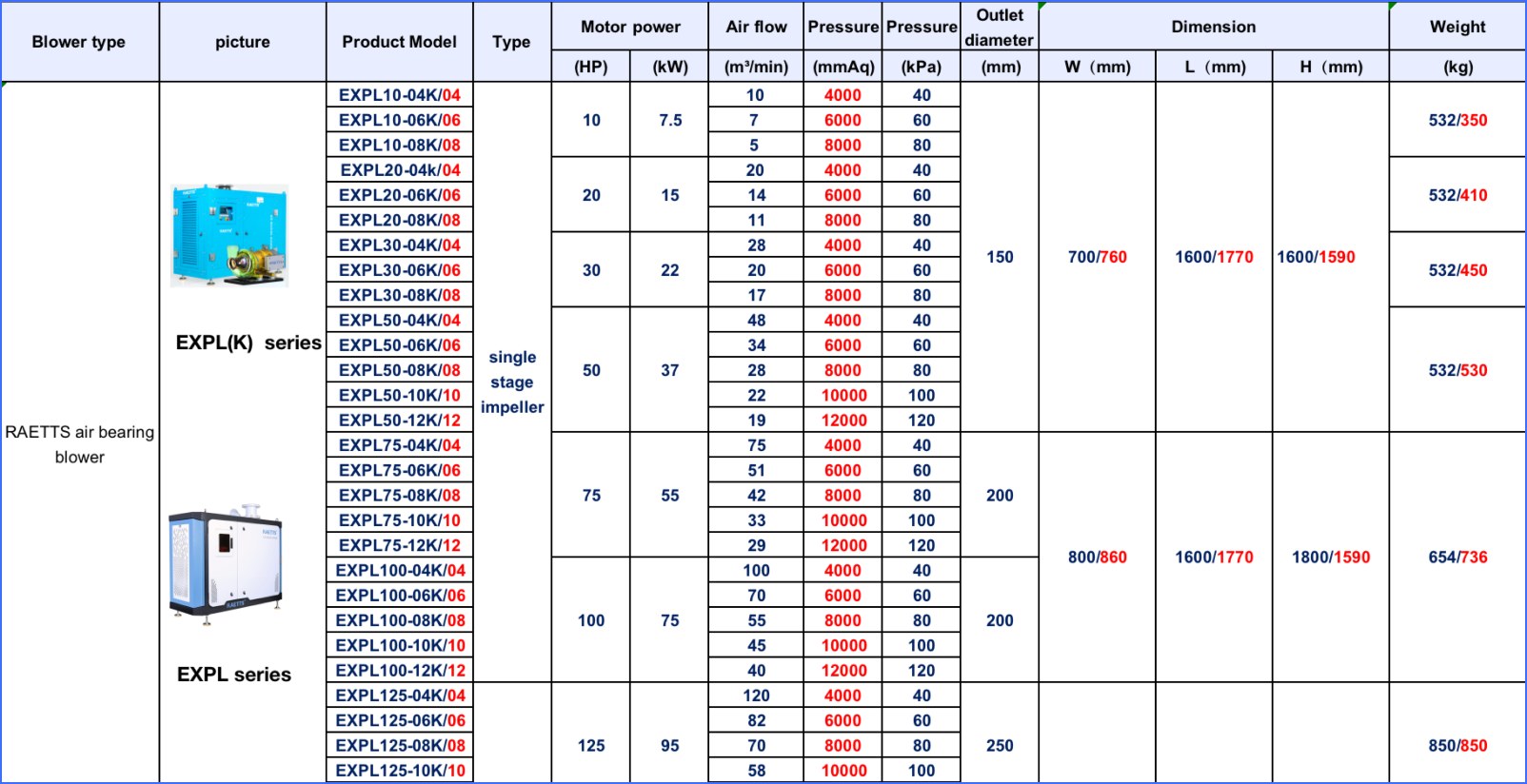
Air blower-An Ultimate FAQ Guide:
2.What Are the Common Noise Levels Associated with Different mini air blower Models?
3.About mini air blower delivery date
4.What is the size of the air blower?
5.What is the operating temperature range of the air blower?
6.About mini air blower R&D capabilities
7.About mini air blower overseas warehouse
8.About mini air blower technology
9.What are the common applications of an mini air blower?
10.About the development history of mini air blower factory
11.How to Properly Maintain and Extend the Lifespan of Your Air Blower?
12.About mini air blower production capacity
13.About mini air blower MOQ
14.About mini air blower warranty
15.About mini air blower production equipment
16.What are the key factors to consider when selecting an air blower for industrial use?
17.About mini air blower inventory
18.What are the advantages of using an turbo mini air blower?
19.What is the operating voltage of the air blower?
20.How has air blower technology evolved over time?
1.How to choose the right mini air blower for your specific needs?
General speaking,we will do model selection of air blower according to customer’s required air flow,air pressure,application,installation altitude,suction media.
2.What Are the Common Noise Levels Associated with Different mini air blower Models?
The noise levels associated with different air blower models depend largely on the size and operating speed of the blower. Smaller blowers tend to be quieter than larger ones. Generally, blowers with higher operating speeds will produce more noise than those running at lower speeds.
Centrifugal blowers tend to be the loudest of the three main types of air blowers. An air blower model with a 2-5 horsepower rating typically produces between 60 and 85 dB(A). Larger models with 5-10 horsepower ratings can usually produce between 75 and 100 dB(A).
Axial flow blowers are typically quieter, with an air blower model with a 2-5 horsepower rating usually producing between 50 and 75 dB(A). Models with 5-10 horsepower ratings usually produce between 65 and 90 dB(A).
Regenerative blowers are the quietest of the three main types of air blowers. An air blower model with a 2-5 horsepower rating usually produces between 45 and 70 dB(A). Models with 5-10 horsepower ratings usually produce between 55 and 85 dB(A).
It is important to note that noise levels associated with air blower models can vary significantly based on the design of the blower, the efficiency of the motor, and the environment in which it is operating. For instance, more efficient motors tend to generate less noise, and the noise levels generated by a blower can increase when it is operated in an environment with poor ventilation.
3.About mini air blower delivery date
For the regular model air blowers(air suspension blower and maglev turbo blower) which RAETTS is producing,the common delivery time will be 30-40 days.For Super air blower and EXPLORER series high speed centrifugal air blower,delivery date is about 10 days.For some other R&D products,RAETTS delivery data is about 3-4 months.
4.What is the size of the air blower?
The air blower size and power depend on the application for which it is used for. Generally, midsize air blowers range from 3-4 to 7-8 horsepower (hp) for small workshops. For large workshops and industrial applications, air blowers with a power of 10 to 20 hp are used. The size of the air blower also depends upon the amount of air flow it needs to generate. Low-power air blowers have a capacity of 100 CFM (cubic feet per minute) and high-power air blowers can range from 600 to over 5,000 CFM.
In addition to the horsepower and air flow measurements, the size of the air blower is determined by its structural dimensions. It includes the width, length, depth and height. Though, small and large air blowers have the same horsepower and air flow, the frame sizes vary. Smaller, more compact blowers are typically more maneuverable and are ideal for operations where space is limited. This makes them more desirable for professional mechanics, hobbyists, and woodworkers. Medium-size air blowers have larger frames, providing higher airflow but have limited maneuverability. This makes these blowers more suitable for large workshops and industrial applications.
The size of the air blower also depends upon its efficiency and portability. Smaller air blowers are lightweight and more efficient in terms of energy consumption compared to larger models. This is the reason why mechanical workshops prefer smaller air blowers as they can be easily placed and adjusted in tight spaces. On the other hand, large blowers require large wall outlets and a large area of operation. Their motors also require more power, which is reflected in their greater energy consumption.
5.What is the operating temperature range of the air blower?
The operating temperature range of an air blower varies depending on the type and size of the blower. Generally, air blowers can operate at temperatures ranging from 40°F (4.4°C) to 250°F (121°C).
Smaller air blowers, such as those found in computers and electronic systems, operate within a much smaller temperature range. These systems typically run between 0°F and 140°F (-17.7°C and 60°C).
Large air blowers, such as those used in industrial or commercial settings, have a much wider operating temperature range. These systems can handle temperatures up to 500°F (260°C). At these temperatures, it is critical to monitor both the air blower and the actual output to ensure the system is not overworking or underperforming.
When designing an air blower system, it is important to select components that are rated for the particular operating temperature ranges. Components made out of materials that can withstand high temperatures, such as nickel-plated brass or stainless steel, are typically best suited for long-term use.
Since air blowers are intended for use in various temperature extremes, it is important to account for any potential changes during operation. Increases in air temperature can lead to decreased performance, while decreases in air temperature can result in decreased output.
Furthermore, all air blowers should be operated within a safe range of temperature to avoid any potential damage to the blower or the surrounding environment. For this reason, regular monitoring of the system should always be conducted to ensure the health and safety of everyone involved.
6.About mini air blower R&D capabilities
RAETTS R&D team has more than 20 people,the chief team leader worked for BYD before,and the technique of whole team is supported by Xi’an Jiaotong University.
7.About mini air blower overseas warehouse
RAETTS is cooperating with global distributors,some distributors has stock or sample in their warehouse.For now,RAETTS has Germany factory warehouse,and we are building the USA warehouse.
8.About mini air blower technology
RAETTS air bearing blower technology is originated from South Korea and maglev turbo blower technology is originated from Germany.RAETTS also have R&D team from Xi’an Jiaotong University.
9.What are the common applications of an mini air blower?
The air blower can be applied for wastewater treatment aeration,pneumatic conveying,sandblaster,combustion support,galvanization,air knife drying,aquaculture oxygenation,fish farming,etc.
10.About the development history of mini air blower factory
RAETTS was set up in the year of 2011,the first product is super series high speed centrifugal blower(belt-drive type).The second product is developed in 2014,it is the direct-drive type high speed centrifugal blower,higher efficiency than belt-drive type.Both of this two blowers are used as the air source of the air knife drying systems.The air bearing blower was developed in 2018 and maglev turbo blower was developed in 2019.In 2020,we developed turbo compressor,which is to meet different applications which need higher pressure.
11.How to Properly Maintain and Extend the Lifespan of Your Air Blower?
Your air blower is an important machine that helps regulate the air you take in and the quality of air your environment receives. Properly keeping it functioning properly will not only help extend its lifespan significantly but also the useful life of other equipment around it. To help properly maintain your air blower and increase its longevity, follow these tips:
1. Clean the Intake.
Regularly check the intake filter and clean it using a damp cloth or vacuum cleaner. This will help ensure that dust and particles don’t build up and clog the engine.
2. Check for Foreign Objects.
Periodically check for any foreign objects inside and around the air blower. This can help you avoid any mishaps and keep your machine running smoothly.
3. Inspect the Interior.
It is important to occasionally disassemble the air blower and inspect the interior for any broken or worn-out parts. This will help you detect any potential problems and allow you to repair them before they can affect the machine’s performance.
4. Regularly Maintain and Service.
Regularly service and maintain your air blower by making sure all lubricants and fluids are replenished and parts are replaced if needed. This will ensure that all parts are functioning as they should, helping keep the machine working at its peak performance.
By following these steps, you can help ensure your air blower runs properly and prevent any potential problems that may lead to it needing replacement or repairs sooner than it should. With regular maintenance and care, your air blower can be in tip-top condition and have a longer lifespan.
12.About mini air blower production capacity
RAETTS production quantity for air bearing blower and maglev turbo blower is about 200pcs/month,for high speed centrifugal blower is about 700pcs/month.
13.About mini air blower MOQ
Normally our MOQ for air blower is 1 set
14.About mini air blower warranty
RAETTS warranty time for air bearing blower and maglev turbo blower is 24months,for high speed centrifugal blower is 12 months.
15.About mini air blower production equipment
RAETTS production equipments are including:Germany imported HERMLE five-axis processing center,AFMING five-axis processing center,Japan Mazak CNC machine tool,sheet metal production and processing center,JIR fine CNC processing center,LEADMA CNC processing center,DOOSAN CNC machine tool,test center,accembly center,motor production center,MAKE laser cutting machine,LFK bending machine,Sweden HEXAGON three coordinate inspection instrument and so on.
16.What are the key factors to consider when selecting an air blower for industrial use?
The decision to choose an air blower for industrial use can depend on many factors. Here are the key factors that should be considered:
Power: Air blowers come with various power ratings, ranging from 0.2 kW to 25 kW, depending on the application. Choosing the right amount of power will help ensure optimal performance of the blower.
Design: The design of an air blower varies according to the application it is meant for. Depending on the need, choosing the right type of blower will help to ensure efficient and productive use.
Connectivity: Air blowers can be connected in several ways. Selecting the correct air blower with the right type of connection like plug type, air-cooled/water-cooled systems, or through a flexible hose is essential.
Durability: Air blowers come in different materials, some of which are cooler and stronger than others. Choosing the right material to suit the job requirements will ensure that the air blower has a longer service life.
Energy Efficiency: It is important to look for air blowers that have the best energy efficiency ratings. A blower with a high rating will consume less electricity and help reduce operational costs.
17.About mini air blower inventory
For air bearing blower and maglev turbo blower,RAETTS doesn’t make stock,only produce air blower according to customers order(since different application site may need different designs).For high speed centrifugal blower,RAETTS makes stock.
18.What are the advantages of using an turbo mini air blower?
Comparing with tradition roots blowers,single-stage blowers and multi-stage blowers,turbo blowers effciency is 20%-30% higher,which means using an turbo air blower can help customer to save about 20-30% energy,and then reduce the eletric cost.
19.What is the operating voltage of the air blower?
The operating voltage of an air blower typically depends on its size and power output. Most air blowers are designed to run on either 110V or 220V AC power. For example, a larger blower with more power may require a 220V power source while a smaller blower with less power may only need 110V. Additionally, it is important to note that many air blowers have both 110V and 220V models, and the user should choose the right model to match the existing power infrastructure of the given application.
20.How has air blower technology evolved over time?
Air blower technology has evolved over time in many ways to make it more efficient, reliable, and cost-effective. Since the beginnings of air blower technology, blowers have become more tenacious and lighter due to the advent of composite materials and improved engineering techniques.
Initially, most air blowers were powered by combustion engines, typically gasoline or diesel. Despite their efficiency, combustion engines pose a number of potential safety hazards and may be expensive to run. Today, the majority of air blowers are powered by electric motors, sometimes referred to as “turbo” motors, which provide more power with greater energy efficiency.
As far as performance is concerned, most air blowers now feature variable-speed control, which allows users to adjust the airflow output to fit the requirements of the job. Variable-speed control not only makes air blowers more efficient but also reduces the amount of time needed for repairs and maintenance. Additionally, many air blowers today are manufactured with eco-friendly designs that help to reduce energy consumption.
To meet the needs of the commercial market, air blowers are now built with advanced features such as digital temperature control and pressure gauges. This allows users to precisely set the desired temperature and pressure for their applications, while other features like low-noise motors make them easier to operate in quiet environments.
Air blower technology continues to improve, and manufacturers are now putting out models capable of speeds up to 15,000 RPM. This high level of performance helps to increase the efficiency of an air blower’s airflow, resulting in a faster work rate and even greater energy savings.
Overall, air blower technology has seen tremendous improvement over the years, from combustion engines to digital temperature control and high-speed motors. These advancements have helped to bring air blowers into the modern age, offering users greater ease of use and energy efficiency.
Tag:leaf air blower

